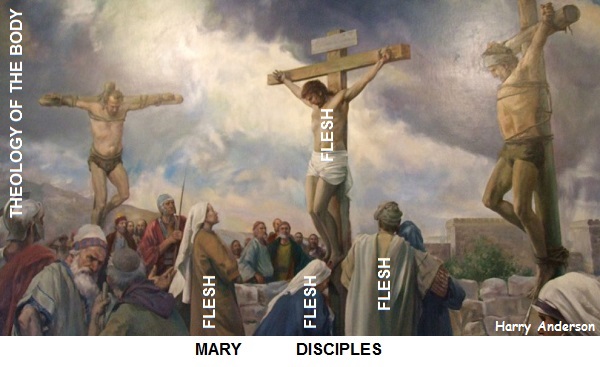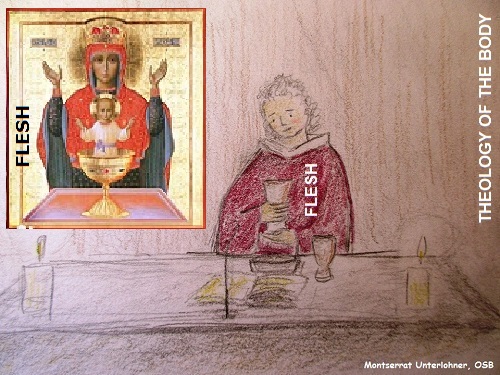The Body is a Sacrament of the Person
Luis Gutierrez
1 March 2017
First Sunday of Lent
The body is a sacrament of the entire person, but is not the entire person. Based on the Catholic sacramental tradition and St. John Paul II’s Theology of the Body, this article explores how to finally make the sacramental economy fully inclusive by ordaining women to the priesthood and the episcopate. It is argued that not one iota of Catholic dogma would have to change by finalizing the transition from the patriarchal priesthood of the Old Law to the sacramental priesthood of the New Law. The sacramentality of the human body is reaffirmed. The signs of the times are propitious. The pastoral need is very urgent, not only for the mission of evangelization but to foster integral human development and attaining an integral ecology. By the power of the keys, the Church does have authority to ordain women, for the glory of God and the good of souls.
Back in the 1970s, I was very active in various lay communities in the Catholic Church. Desiring to be informed about authoritative pronouncements of the magisterium, I subscribed to the weekly English edition of L'Osservatore Romano, which in those days was delivered in hard copy via air mail. In the fall of 1979, Pope John Paul II started delivering a new series of talks at the weekly general audience about the book of Genesis, focusing on the creation of man and woman. I had been on retreat that summer, found peace and was in a receptive mood. Sensing that this was a papal response to newly emerging issues of human sexuality and gender, I started reading the articles as they arrived, week after week.
I didn't know at the time that the good pope was using material from a book he had written about human anthropology and the sacramentality of marriage. But the stuff sounded relevant to deepen my understanding and experience as a married man, and he was addressing issues very much related to the "signs of the times," so I kept reading the weekly lessons, which went on for about five years, 1979 to 1984. Actually, I got hooked on the "theology of the body" early on when I read the lesson given 7 November 1979. In this lesson, the pope said something that was a new insight for me:
"Bodiliness and sexuality are not simply identical. Although in its normal constitution, the human body carries within itself the signs of sex and is by its nature male or female, the fact that man is a "body" belongs more deeply to the structure of the personal subject than the fact that in his somatic constitution he is also male or female. For this reason, the meaning of "original solitude," which can be referred simply to "man," is substantially prior to the meaning of original unity; the latter is based on masculinity and femininity, which are, as it were, two different "incarnations," that is, two ways in which the same human being, created "in the image of God" (Gen 1:27), "is a body."" The Meaning of Original Unity, Pope John Paul II, 7 November 1979. Source: Man and Woman He Created Them: A Theology of the Body, Pauline Books & Media, 2006, page 157.
Surely, being a body is consistent with my understanding that man is a rational animal composed of body and soul. But I had always thought of myself as a man, a male of the human species; and, for me, being a body and being a male were "simply identical." It had never occurred to me that being a "body-soul" was ontologically more essential than being a "male body-soul" or a "female body-soul." Sigmund Freud used to say that "anatomy is destiny", and this is true to some extent; but now I understood that sexual anatomy does not exhaust the reality of the human being as a "personal subject." There are many layers of reality between a male or female body and a body-soul. Human bodies are male or female (or, in some cases, intersex), but human beings are embodied persons. The body is a sacrament of the entire person, but is not the entire person.
Later in the same lesson, while explaining the creation of man and woman as personal subjects based on Genesis 2, the pope reiterates the "homogeneity of the whole being of both." This means that all men and women share one and the same flesh, one and the same human nature as spirited bodies. It is the same flesh that was created from dust and made a living being (Genesis 2:7). It is the same flesh that was differentiated into two "incarnations," male and female (Genesis 2:23). And it is the same flesh that was assumed by the eternal Word at the incarnation (John 1:14). Thus there is a fundamental unity of man and woman; a unity than is not cancelled by sexual differences and other forms of diversity.
Actually, and this is explained in subsequent lessons, it is this fundamental unity that makes possible the complementarity of man and woman. In John Paul II's theology of the body, this complementarity is never reduced to a superficial complementarianism of patriarchal gender stereotypes. Surely, and thankfully, man and woman are different; but they are both body-souls, of the same flesh, and they can complement each other precisely because they share one and the same human nature. The complementarity of man and woman is about becoming one flesh (in the conjugal act and in many other ways pursuant to integral human development) not about excluding each other in conformity with cultural gender stereotypes.
In the lesson given at the general audience of 20 February 1980, another significant insight was provided: "The body, in fact, and only the body, is capable of making visible what is invisible: the spiritual and the divine." Again, the body is a sacrament of the entire person but is not the entire person. The body makes the integral human person visible. The body also makes divine persons visible in their uniqueness, their complementarity, and their unity in communion. For instance, it makes visible the divine "feminine genius" in Jesus of Nazareth. We know that "Through him all things were made; without him nothing was made that has been made." (John 1:3) So if there is a feminine genius, and a masculine genius, both are present in Jesus Christ, fully God and fully man. The body, and body language, makes visible what is invisible.
The first part of the theology of the body is an exegesis of the book of Genesis, and provides a theological anthropology that is fully adequate for the sacramental economy. The second part is about the sacramentality of marriage, and includes many profound insights on the nuptial mystery of Christ and the Church. For instance, the lesson given 30 July 1980 explains how nuptial analogies should be interpreted taking into account both similarities and substantial dissimilarities. Surely, the bridegroom-bride analogy of Ephesians 5 should not be reduced to a patriarchal wedding covenant; which may be the reason it is rarely chosen anymore as readings for Catholic weddings.
What about Mary, the Mother of Jesus and Mother of God? There is a vital bodily connection between the Word becoming flesh and the woman in which the Word became flesh, as flesh of her flesh (Galatians 4:4). There is a connection, in the flesh, between the Virgin Mary, the incarnation, the redemption, and the sacramental economy. If Mary is the Mother of Jesus, and the Mother of God, then she is also the Mother of the Eucharist. This brings to mind serious questions about the sacrament of holy orders. If the Virgin Mary brought us the Incarnate Word in her own body, as flesh of her flesh, why is the redeemed body of a baptized woman, of the same flesh, not "proper matter" for priestly ordination? If Mary bodily participated in the incarnation necessary for the redemption (long before the twelve male apostles became apostles!) why should the Church hierarchy be exclusively male?
What about Mary Magdalene, "apostle to the apostles"? We know that, during his public ministry, Jesus chose twelve male apostles to represent the patriarchs of the twelve tribes of Israel. After the resurrection, however, it is reasonable to assume that he appeared first to his mother. And who was next? Mary Magdalene, who is quickly dispatched to bring the good news to the apostles. In the gospel of John, we learn about the Samaritan woman, sent in apostolic mission to announce the Messiah to her neighbors while the apostles looked in disbelief, incapable of understanding that Jesus would even talk to a woman in public. What about Mary of Bethany, who anointed Jesus, on his head, with his permission, in preparation for his passion and burial? The apostles were male body-souls. These women were female body-souls. Before the resurrection, patriarchy prevailed. After the resurrection, the stone has been rolled away from the entrance of the tomb!
I think (my personal opinion) that the theology of the body can and should be extended to all the sacraments, including holy orders and the vexing issue of the ordination of women to the Catholic priesthood. See, for example, the beautiful lesson given 6 October 1982 about "marriage as the primordial sacrament." Can a male human body make visible the divine feminine genius in Christ? Yes. Can a female human body make visible the divine masculine genius in Christ? Yes. Why? Because the language of the body is liturgical, so it signifies man and woman being imago Dei, and becoming imago Christi, as persons and as a communion of persons (Cf. General Audience, 4 July 1984). Women cannot be biological fathers, and men cannot be biological mothers, but man and woman are created to become one flesh in all dimensions of the sacramental economy.
It should be mentioned that a healthy interpersonal communion (unity in complementarity) between man and woman is indispensable for integral human development. The personal development of a man remains at the superficial level of anatomical masculinity as long as his ways of thinking and acting do not make visible the divine "feminine genius." Likewise, the personal development of a woman remains at a superficial level of anatomical femininity as long as her ways of thinking and acting do not make visible the divine "masculine genius." Such balancing of the masculine and the feminine, in each personal subject and in every human community, is instrumental for a culture of solidarity and sustainability. Among the baptized, such balancing of the masculine and the feminine makes visible the universal inclusivity of the sacramental economy and the mystical body of Christ; even further, it makes palpable the entire community of creation as a sacramental ecology that, even in our already/not yet, renders the cosmic Christ visible.
This is my understanding of this monumental work, the Theology of the Body by St. John Paul II. There are precious jewels yet to be found here, for the glory of God and the good of souls. With regard to the ordination of women, it is an indispensable point of reference for doctrinal development in continuity with apostolic tradition. Incidentally, all the lessons in the series are available online in the EWTN website as they were published in L'Osservatore Romano (1979-1984) and subsequently as a book, The Theology of the Body: Human Love in the Divine Plan (1997). The best translation available is the one by Michael Waldstein, Man and Woman He Created Them: A Theology of the Body, 2006.

Icon of the Mother of God ~ Inexhaustible Chalice


|Back to Title|
PelicanWeb Home Page
Index of Meditations
|